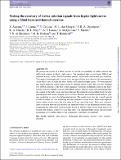Testing the recovery of stellar rotation signals from Kepler light curves using a blind hare-and-hounds exercise
View/
Date
01/07/2015Author
Funder
Grant ID
ST/I000666/1
PP/D000890/1
ST/M001296/1
ST/G001006/1
PP/F000065/1
Keywords
Metadata
Show full item recordAbstract
We present the results of a blind exercise to test the recoverability of stellar rotation and differential rotation in Kepler light curves. The simulated light curves lasted 1000 d and included activity cycles,Sun-like butterfly patterns, differential rotation and spot evolution.The range of rotation periods, activity levels and spot lifetime were chosen to be representative of the Kepler data of solar-like stars. Ofthe 1000 simulated light curves, 770 were injected into actual quiescent Kepler light curves to simulate Kepler noise. The test also included five 1000-d segments of the Sun's total irradiance variations at different points in the Sun's activity cycle. Five teams took part in the blind exercise, plus two teams who participated after the content of the light curves had been released. The methods used included Lomb-Scargle periodograms and variants thereof, autocorrelation function and wavelet-based analyses, plus spot modelling to search for differential rotation. The results show that the 'overall' period is well recovered for stars exhibiting low and moderate activity levels. Most teams reported values within 10 per cent of the true value in 70 per cent of the cases. There was, however, little correlation between the reported and simulated values of the differential rotation shear, suggesting that differential rotation studies based on full-disc light curves alone need to be treated with caution, at least for solar-type stars. The simulated light curves and associated parameters areavailable online for the community to test their own methods.
Citation
Aigrain , S , Llama , J , Ceillier , T , Chagas , M L D , Davenport , J R A , García , R A , Hay , K L , Lanza , A F , McQuillan , A , Mazeh , T , de Medeiros , J R , Nielsen , M B & Reinhold , T 2015 , ' Testing the recovery of stellar rotation signals from Kepler light curves using a blind hare-and-hounds exercise ' , Monthly Notices of the Royal Astronomical Society , vol. 450 , no. 3 , pp. 3211-3226 . https://doi.org/10.1093/mnras/stv853
Publication
Monthly Notices of the Royal Astronomical Society
Status
Peer reviewed
ISSN
0035-8711Type
Journal article
Description
SA’s contribution to this work was supported by the UK Science and Technology Facilities Council through Consolidated Grant ST/K00106X/1. JL acknowledges support through NASA/GALEX grant program under Cooperative Agreement No. NNX12AC19G issued through the Office of Space Science. MLdC acknowledges a CAPES/PNPD fellowship. JRdM and MLdC acknowledge financial support of the INCT INEspac¸o. TC and RAG want to acknowledge the funding of the CNES grant at the CEA, as well as the ANR (Agence Nationale de la Recherche, France) program IDEE (n ANR-12-BS05-0008) ‘Interaction Des Etoiles et des Exoplanetes’.Collections
Items in the St Andrews Research Repository are protected by copyright, with all rights reserved, unless otherwise indicated.

